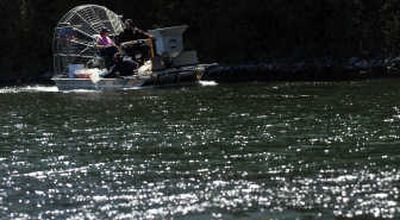Workers fighting noxious weed

The effort continues to combat an aquatic weed infesting much of Eastern Washington and North Idaho’s waters.
Treatment for Eurasian milfoil started Monday on about 217 acres of Hayden Lake and will be continued with herbicide over the next couple of days. The same type of treatment was applied to Liberty Lake last year and will be applied next month to parts of Newman and Coeur d’Alene lakes, among others.
But experts say the weed will never completely go away.
“Once it’s in a waterway, it’s pretty much there,” said Nina Eckberg, Kootenai County weed supervisor and chairwoman of the Inland Empire Cooperative Weed Management Area. “It’s totally a control issue.”
Eurasian milfoil first showed up on Hayden Lake in 1998. One piece of the weed can start an infestation, meaning a propeller with a few scraps of milfoil can spread an infestation from one lake to another. The weed grows underwater and can eventually reach the surface, forming a dense layer that can tangle swimmers and hinder boats. The 2006 Idaho Legislature allocated $4 million to fight the weed. The treatment on Hayden Lake is funded through a $200,000 grant from the state money.
The herbicide used on the lake prevents using the water for drinking or irrigation for five days or until tests show it’s safe. A 24-hour swimming ban is recommended but not required. Once the herbicide treatment on Hayden Lake is complete, divers will remove milfoil remnants by hand and with vacuums, a time-consuming process called diver dredging that Eckberg said isn’t safe in the dense milfoil infestations.
Most of the milfoil is on the northeastern part of Hayden Lake, where the water is shallow. The weed doesn’t usually grow in water deeper than 20 feet, Eckberg said. After the Hayden Lake treatment is complete, the county will use leftover grant money to treat 187 acres on Medicine and Cave lakes. Officials might request more state funds, depending on the cost of the Hayden Lake treatment, Eckberg said.
Eurasian milfoil showed up on Liberty Lake in 1995 and has been treated regularly since, said BiJay Adams, water resource manager for the Liberty Lake Sewer and Water District.
“Since we caught it early, we haven’t had any of the real beds of milfoil,” he said.
The district treated about 12 acres of Liberty Lake with herbicide last week and will run water quality tests this week, Adams said.
“It’s one of those species of plants that, if left unmanaged, the lake would be completely infested to the point that it would impede on recreation, swimming and aesthetics,” he said. “The big goal is just to keep it from being too established.”
Hauser Lake doesn’t have milfoil, and officials installed a boat rinse in May they hope will keep it that way. Boat owners are asked to clean their boats of any weeds or debris before entering the lake.
Eckberg said the easiest way to fight the weed is through boater awareness.
“It’s actually an easy fix,” she said. “If they would clean off their boats, it would really reduce infestations.”
Much of the Eurasian milfoil on Lake Coeur d’Alene grows in tribal waters, Eckberg said.
The tribe is surveying the lake to find infestations and determine which to treat first, said David Lamb, lake ecologist for the Coeur d’Alene Tribe.
“It’s pretty much at the south end of the lake,” Lamb said. “But … it has a great potential to move north and infest other areas.”
The tribe will use herbicide next month on about 600 acres of the lake that have thick infestations. Approximately 1,000 additional acres have some milfoil present, Lamb said.
In Washington, Newman Lake has about 30 acres infested with Eurasian milfoil that will be treated with herbicide in August, said Jacob McCann, a water quality technician with Spokane County. The weed was discovered in 2002. Regular treatments have kept it from spreading in the 1,200-acre lake, McCann said.
“The goal is maintenance as opposed to complete eradication,” McCann said. “It’d be nice to completely get rid of it, but maintaining what you have is a little bit more feasible.”
Lamb said officials will be visiting the north end of Lake Coeur d’Alene this week to look for milfoil in places such as Micah Bay, Kidd Island Bay and Cougar Bay. No milfoil has been reported there, but with the summer activity, the potential is great, he said.